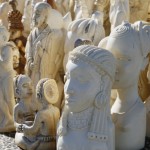Objects crushed by U.S. Fish and Wildlife Service, November, 2013 (Rick Wilking/Reuters)
In the past couple of years the sale of ivory has become fraught with legal jeopardy. A shot across the bow was fired in the Spring of 2012 when a squad of armed officers of California’s Fish and Game service, on behalf of the Federal Government, raided Slawinksy’s Auction house in northern California. Approximately $150,000 worth of ivory objects and objects decorated with ivory was confiscated. The property was eventually returned after it was determined that the ivory offered for sale was in compliance with Federal Endangered Species Act (ESA) which allows the sale of ivory more than 100 years old or if acquired before ESA’s enactment. On November 13th, 2013, the U.S. Fish and Wildlife Service dramatically signaled its intention to crack down on the global poaching epidemic by crushing 6 tons of illegal ivory at the Rocky Mountain Arsenal National Wildlife Refuge in Colorado. Three months later, on February 11, the Federal government announced new regulations prohibiting all importation of ivory objects including antiques. The export of worked ivory which has documentation proving it to be more than 100 years old is allowed. Selling documented antique ivory across state lines remains lawful, as well as ivory objects that were imported prior to the 1989 ban on African ivory or the 1976 ban on Asian ivory. A major development of this new law is that the burden of proof of age and date of importation falls on the importer, exporter or seller.
In California, the sale of ivory is even more restricted. California Penal Laws 653o and 653p ban the sale, or possession with intent to sell of ivory, within the state or across state lines. The law reads as follows:
It is unlawful to import into this state for commercial purposes, to possess with intent to sell, or to sell within the state, the dead body, or any part or product thereof, of any polar bear, leopard, ocelot, tiger, cheetah, jaguar, sable antelope, wolf (Canis lupus), zebra, whale, cobra, python, sea turtle, colobus monkey, kangaroo, vicuna, sea otter, free-roaming feral horse, dolphin or porpoise (Delphinidae), Spanish lynx, or ELEPHANT.
Penalties for violating Penal Law 653o are as follows:
Any person who violates any provision of this section is
guilty of a misdemeanor and shall be subject to a fine of not less
than one thousand dollars ($1,000) and not to exceed five thousand
dollars ($5,000) or imprisonment in the county jail not to exceed six
months, or both that fine and imprisonment, for each violation..
Although California Penal Law 653o has been on the books since 1970, it has not been enforced until early 2012. However, it appears that strict enforcement of this law prohibits the sale of all ivory objects whether antique or not. So, ivory owner beware: if you have in your possession a collection of Japanese netsuke, Chinese carved tusks or statues, scrimshaw, furniture or a musical instrument embellished with ivory and are contemplating selling it, contact an attorney.


